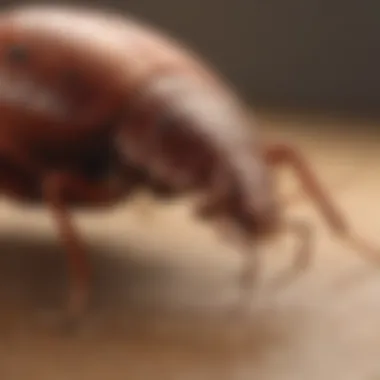Comprehensive Approaches to Bed Bug Itch Treatment


Research Context
Background Information
Bed bug infestations have re-emerged as a significant public health concern in recent years. These small, nocturnal insects feed on human blood and can cause not only physical discomfort but also psychological distress. The itching that accompanies bed bug bites results from an allergic reaction to the insect's saliva. Understanding the physiological mechanisms behind itching is essential for developing effective treatment solutions.
Importance of the Study
This study delves into the multifaceted issue of bed bug-related itching, aiming to provide a comprehensive overview of treatment options available. Given the growing prevalence of bed bugs, addressing the psychological and physical impacts incurred through such infestations is crucial. The insights garnered from this exploration can assist individuals, healthcare professionals, and educators in mitigating the discomfort caused by bed bug bites.
Discussion
Interpretation of Results
Senstitivity to itching varies among individuals, influenced by various factors such as skin type and immune response. Treatments range from over-the-counter remedies like hydrocortisone cream to alternative remedies such as natural oils. This discourse on different modalities offers a detailed perspective on how both conventional and alternative methods can be effectively integrated into one’s personal care regimen.
Comparison with Previous Research
Historically, many treatments focused solely on alleviating physical symptoms, often neglecting the psychological aspects. Recent studies emphasize the need for a dual approach: alleviating the immediate itching while also addressing anxiety related to bed bug infestations. By comparing diverse studies, it becomes clear that a comprehensive strategy addressing both dimensions is more effective than treating symptoms in isolation.
"A holistic approach to bed bug itch treatment fosters understanding and empowers individuals toward effective resolution of their symptoms."
Moreover, the effectiveness of certain treatments can vary widely. For example, while some may find immediate relief with topical agents, others might prefer more homeopathic solutions that promise long-term effects. This section serves as a bridge between established norms and innovative approaches, encouraging further exploration and personalized treatment plans.
Understanding Bed Bugs
Understanding bed bugs is crucial in addressing the issues related to their bites and the subsequent itch they cause. This section provides essential insights into bed bug biology and behavior, which will lay the foundation for later discussions on treatment and prevention strategies. By comprehending how bed bugs function and reproduce, individuals are better equipped to manage infestations and mitigate the discomfort caused by their bites.
Biology and Behavior
Bed bugs are small, parasitic insects that primarily feed on human blood. Scientifically known as Cimex lectularius, these pests are nocturnal, usually emerging during the night to feed. Their bodies are flat and oval-shaped, making it easy for them to hide in crevices and seams of furniture, especially in mattresses and bed frames.
Understanding their biology is key to controlling their populations. They are attracted to warmth and carbon dioxide, which is produced by sleeping humans. The adult bed bug can live several months without feeding, allowing it to survive in a dormant state. Female bed bugs lay hundreds of eggs during their lifetime, which can further exacerbate infestations if not managed properly.
Life Cycle and Infestation Patterns
The life cycle of bed bugs consists of several stages: egg, nymph, and adult. The egg stage lasts about a week, during which each female can lay up to five eggs per day. Nymphs, which resemble smaller adults, undergo five molts before reaching full maturity. Each stage requires a blood meal for development. This cycle contributes to the rapid growth of infestations, making prompt action essential.
Infestations commonly spread through travel, used furniture, and clothing. Once bed bugs infiltrate a home, they establish colonies by hiding in various places. Common hiding spots include:
- Mattresses and Box Springs: Their preferred locations due to proximity to hosts.
- Furniture Stitches and Seams: Places where cracks are found.
- Walls and Baseboards: Including behind wall hangings and switches.
"Understanding the behavior and life cycle of bed bugs is fundamental for effective treatment and prevention strategies."
In summary, comprehending the biology, behavior, and life cycles of bed bugs provides valuable information for tackling infestations. Through awareness, individuals can recognize signs of bed bugs early, enabling timely treatment and minimizing discomfort.
Mechanism of Itching
Understanding the mechanism of itching is crucial in comprehending how bed bug bites affect individuals. This knowledge not only aids in selecting appropriate treatment options but also helps in mitigating the overall impact of infestations. Itching is a complex physiological response, influenced by various factors including the body’s immune reactions and the characteristics of bed bug saliva.
How Bed Bug Saliva Affects the Skin
When a bed bug bites, it injects saliva that serves multiple purposes. The saliva contains anticoagulants, which prevent the blood from clotting, allowing the bed bug to feed effectively. However, this saliva also introduces foreign proteins into the skin's surface, triggering a response.
These proteins are recognized by the body as invaders, leading to an inflammatory response. This reaction is necessary for healing but results in itching. The severity of itching can vary depending on individual sensitivity and allergic reactions to these proteins. Some people may experience intense itching, while others might feel minimal discomfort.


In summary, bed bug saliva plays a key role in the itching mechanism, and its effects can illuminate better treatment approaches.
Immune Response to Bites
The immune response to bed bug bites is another critical aspect of understanding how to manage itching effectively. Upon detecting the foreign substances introduced by the bite, the body activates the immune system.
This response results in several biochemical processes, primarily involving histamines. Histamines are chemicals released by cells as part of the immune reaction, which cause itchiness and swelling in the affected area. The symptom of itching often escalates as the body mobilizes more immune cells to combat the perceived threat.
Additionally, some individuals may develop an allergic reaction to bed bug bites. This type of response can be more pronounced, leading to severe itching and swelling far beyond the initial bite site. Chronic scratching of the affected areas can lead to secondary infections. Thus, understanding this immune response is crucial in treating and preventing complications that arise from scratching and prolonged irritation.
The intensity of the immune response can significantly influence the management of itching and the choice of treatment options.
Common Symptoms of Bed Bug Bites
Understanding the common symptoms associated with bed bug bites is crucial in the quest for effective treatment. Recognizing these symptoms can facilitate timely intervention, preventing further discomfort and potential complications. Bed bug bites typically manifest as small, red welts that may appear in clusters or patterns. This visual clue serves as an essential identifier, distinct from other insect bites, thus underscoring the need for awareness among infested individuals.
Another significant aspect of these bites is the itchiness they provoke. The level of irritation may vary depending on individual sensitivity and allergic reactions to bed bug saliva. Itching can lead to scratching, which subsequently increases the risk of secondary infections, emphasizing the importance of distinguishing bed bug bites from other skin irritations.
Bed bug bites may also lead to anxiety and stress due to their association with infestations. This psychological reaction can exacerbate the discomfort caused by the bites. Therefore, comprehensive knowledge about symptoms forms the cornerstone of an effective treatment strategy, guiding individuals on how to manage their reactions.
It is important to note that early detection and identification of bed bug bites can significantly influence the effectiveness of subsequent treatment choices.
Identifying Bite Marks
Bite marks from bed bugs are generally small and often appear as raised, red welts on the skin. They usually have a central puncture, which may look similar to a mosquito bite, but they are distinct in their growth patterns. Recognizing the typical arrangement of bites is also important; they often occur in groups of three or more, known as a "breakfast, lunch, and dinner" pattern. This pattern can help distinguish bed bug bites from other insect bites.
To properly identify these bites, one should look for some common characteristics:
- Size: The bites are usually less than one centimeter in size.
- Location: They are often found on exposed areas such as the face, neck, arms, and hands.
- Itching: A noticeable itch accompanies the bite, which can persist and worsen over time.
Differentiating from Other Insect Bites
Differentiating bed bug bites from those of other insects is essential for accurate treatment. Other insects, like mosquitoes, fleas, or spiders, can cause similar reactions. However, several factors can aid in distinguishing them.
- Time of Bite: Bed bugs are primarily nocturnal and tend to feed while their host sleeps. In contrast, other insects might bite at any time.
- Bite Patterns: Bed bug bites often present in linear patterns, while bites from mosquitoes tend to be sporadic. Flea bites might appear in clusters around the ankles.
- Behavioral Notes: The presence of physical evidence, like fecal stains or shed skins near bed linen or furniture, indicates bed bug activity.
Being vigilant about these details can help individuals make an informed assessment, leading to more effective control measures and treatment options.
Treatment Options for Itching
The exploration of various treatment options for itching caused by bed bug bites is crucial for those impacted by these pests. These options not only provide relief from immediate discomfort but also play a significant role in preventing further complications such as infections. Each treatment modality offers distinct advantages and considerations, making it essential to understand their specifics and applications.
Topical Corticosteroids
Topical corticosteroids are commonly recommended for alleviating itching associated with bed bug bites. Their primary function is to reduce inflammation and suppress the immune response in the affected area. These medications are available in various strengths, allowing for tailored treatment based on the severity of symptoms.
Using topical corticosteroids can significantly ease the itchiness within hours. They are particularly effective in reducing redness and swelling. However, prolonged use is discouraged due to potential skin thinning and other side effects. Patients should follow directions closely and consult their healthcare provider if symptoms persist.
Antihistamines: Oral and Topical
Antihistamines, both oral and topical, are another effective option for managing itchiness. Oral antihistamines work by blocking histamine receptors, which diminishes the itching sensation. Commonly used products include diphenhydramine and cetirizine. These medications can cause drowsiness, which may be beneficial for night-time relief.
Topical antihistamines, while less common, act directly on the skin to provide localized relief. They help to alleviate itch without systemic effects. However, users need to be cautious, since some individuals may experience allergic reactions to topical formulations. Always perform a patch test before extensive application.
Natural Remedies
Natural remedies are often sought by individuals preferring alternative options for symptom relief. Below are specific mentions of three popular remedies:


Calamine Lotion
Calamine lotion is prized for its soothing properties, particularly in relieving itching and irritation. It contains zinc oxide and iron oxide, both of which provide a cooling effect on the skin. Moreover, calamine lotion is easy to apply and can help dry oozing sores, making it suitable for open bites.
One key characteristic of calamine lotion is its minimal risk of side effects, as it is gentle on the skin. However, it may not be as effective for all individuals, particularly with severe allergic responses. Still, it remains a favored choice due to its accessibility and safety profile.
Aloe Vera
Aloe vera is well-known for its healing properties, which extend to itch relief from bug bites. Its unique composition includes anti-inflammatory compounds and moisture-retaining elements. As such, it aids in reducing inflammation and promoting skin healing.
The gel form of aloe vera is especially user-friendly and can be applied directly to the skin. While it is beneficial for most, those with sensitive skin should monitor for any adverse reactions. Its overall effectiveness makes it a popular remedy among many looking for natural alternatives.
Tea Tree Oil
Tea Tree Oil is recognized for its antiseptic qualities, making it a beneficial choice for treating bed bug bites. It can help reduce inflammation and prevent infections, addressing two significant concerns associated with bites. This oil's antibacterial properties are among its most noted characteristics, adding an extra layer of defense against potential complications.
The unique feature of tea tree oil is its concentrated formulation, which means even a small amount can be effective. However, it must be diluted before applying to avoid skin irritation. As with other natural remedies, verifying individual tolerance is essential before widespread use.
Hydration and Moisturization
Maintaining proper hydration and moisturization plays a critical role in managing bed bug itch. Adequate hydration can support skin health, enhancing its natural protective barrier. Moisturizers help soothe irritated skin, providing relief and preventing dryness that can exacerbate itching.
Applying unscented, hypoallergenic moisturizers following treatment can minimize itchiness while keeping the skin supple. It’s a straightforward yet effective component of bed bug itch management, ensuring the skin remains healthy and less prone to irritation.
Psychological Impact of Infestation
The psychological aspect of a bed bug infestation is often underestimated. The presence of these pests does not solely lead to physical discomfort; it also induces significant emotional strain. The stress and anxiety resulting from each bite and the fear of potential infestation can leave lasting effects on an individual’s mental health. Understanding these dynamics is crucial for effective treatment and support.
Stress and Anxiety Associated with Bed Bugs
For many, the discovery of bed bugs marks the beginning of distress. The thought of these insects crawling unseen, especially during the night, can trigger excessive worry. This stress can manifest in several ways, including sleeplessness, irritability, and heightened vigilance when sleeping or relaxing. A person may find themselves constantly inspecting the bed or other furniture, fearing a repeat outbreak.
A study highlighted on Britannica shows that nearly 20 percent of individuals experiencing a bed bug infestation develop chronic anxiety issues. Even after treatment, the psychological effects can linger. Some individuals may develop hypervigilant tendencies, associating any small itch with a potential bite.
"Understanding the psychological implications of bed bugs is as important as addressing the physical symptoms."
Compulsive Behaviors
Infestations can lead to behaviors that many might consider excessive. As an ongoing response to stress and anxiety, individuals may engage in compulsive cleaning. This might include washing bedding multiple times a day or discarding furniture believed to be infested.
In extreme cases, fear of contamination can progress to what is known as "delusional parasitosis," where the infested individual believes they still have bugs even in their absence. Such psychological issues need careful attention. Cognitive behavioral therapy (CBT) can be effective to help individuals address these compulsions and modify harmful thought patterns.
This reveals how intertwined the emotional and physical aspects of bed bug infestations are. Addressing one without the other can hinder recovery. Understanding the psychological impact can significantly aid treatment plans and support systems, providing a more comprehensive approach to managing the aftermath of bed bug infestations.
Preventive Measures Against Infestations
Preventing bed bug infestations is crucial for maintaining comfort and health. A proactive approach can reduce the chances of encountering these pests. Effective prevention strategies encompass several actions, from home inspections to cautious handling of personal items. Understanding how to implement these measures can save time and resources, as well as minimize the emotional stress associated with an infestation.
Regular Inspections
Conducting regular inspections of living spaces is a primary preventive measure. Regular checks help in identifying bed bugs before they become a larger issue. Focus on commonly infested areas such as mattresses, bed frames, and upholstered furniture. Pay attention to seams and folds, which are often favored by bed bugs for hiding.
Consider making a checklist to guide these inspections:
- Inspect sleeping areas at least once a month.
- Move furniture away from walls to examine concealed spaces.
- Look for telltale signs: small dark spots (fecal matter), shed skins, or live bugs.


By detecting bed bugs early through regular inspections, the likelihood of a major infestation decreases greatly, ensuring a more comfortable living environment.
Dealing with Luggage and Second-Hand Items
Bed bugs can easily hitch a ride on clothing or items, especially during travel. It is important to take precautions when dealing with luggage and second-hand items. Here are several effective strategies to minimize risks:
- When traveling, keep luggage off the floor and bed. Use luggage stands when possible.
- Inspect bags and clothing immediately after returning from a trip.
- Wash and dry clothes on high heat before storing them.
- For second-hand items, inspect them thoroughly before bringing them home.
- Look for any signs of bed bugs.
- Consider using a sealed plastic bag to isolate items for a few days or check for pests.
By being vigilant about luggage and second-hand items, individuals can significantly cut down on the chance of an infestation. Safe handling of these items prevents the unintended transfer of bed bugs into living spaces, ultimately protecting one's home from infestation.
When to Seek Medical Attention
Understanding when to seek medical attention for bed bug-related issues is crucial for managing potential complications. While many individuals experience mild symptoms from bed bug bites, certain scenarios can indicate a need for more urgent care. Recognizing these signs can lead to timely interventions, helping to mitigate further health risks. This section highlights the importance of vigilance in monitoring any changes related to itching, bites, or overall health following an infestation.
Signs of Severe Allergic Reaction
A severe allergic reaction to bed bug bites is uncommon but can occur. Individuals with heightened sensitivity may experience a range of symptoms that require immediate medical evaluation. Key indicators include:
- Swelling: Unnormal swelling around the bite site or extending to other areas, like the face or throat.
- Difficulty Breathing: Any feeling of breathlessness or wheezing that emerges after bites warrants prompt attention.
- Rapid Heart Rate: An increased heartbeat can signal an allergic response.
- Hives: The appearance of hives or rashes beyond the bite area signifies a systemic reaction that should not be ignored.
If one experiences these symptoms, it is imperative to seek medical help without delay. A healthcare professional can provide appropriate treatments, such as epinephrine, to counteract severe reactions.
Infection Risks from Scratching
Another critical issue with bed bug bites is the risk of infection, particularly from excessive scratching. Scratching can break the skin barrier, allowing bacteria to enter, which could lead to more severe complications. Here are several factors to consider:
- Redness and Warmth: If the bite area becomes increasingly red, warm or swollen, it might indicate an infection.
- Pus Formation: Any drainage or pus from bites is a common sign of an infection that requires medical assessment.
- Fever Symptoms: A fever or feeling of malaise can suggest that the body is fighting an infection.
To mitigate these risks, it is essential to avoid scratching and to use appropriate treatment methods. Seeking medical attention for signs of infection ensures that any required antibiotics or other treatments are prescribed timely, preventing further complications.
Timely intervention can significantly improve outcomes in both allergic reactions and infections.
In summary, being aware of the signs indicating a need for medical attention is paramount. Prompt action can prevent complications, ensuring better health following a bed bug infestation.
Long-Term Management Strategies
Long-term management strategies for bed bug itch treatment are crucial for those who have experienced infestation. This section aims to highlight the need for a comprehensive approach to not only alleviate symptoms but also to prevent future occurrences. Understanding the various aspects of long-term management can equip individuals with the necessary tools to combat these persistent pests effectively.
One of the primary elements of long-term management is recognizing that bed bugs tend to recur if initial treatments are not thoroughly executed. The challenge lies in understanding their life cycle. Regular monitoring and preventative measures can make a significant difference. Individuals should consider integrating management strategies that go beyond temporary fixes. The benefits include a reduction in anxiety associated with bites and a lower likelihood of developing infections from scratching. It is essential to address both the physical and psychological aspects of dealing with these pests.
Understanding Recurrence and Cycle
Understanding the recurrence of bed bug infestations is vital for effective long-term treatment. Bed bugs have a complex life cycle that includes eggs, nymphs, and adults, which can stretch over several months. Failing to identify and eliminate any stage of this cycle can lead to a reinfestation.
In essence, the process is cyclical. Eggs can linger in hiding spots, often undetected, leading to new nymphs hatching and continuing the cycle. Regular inspections and thorough cleaning routines play essential roles in breaking this cycle. It can be helpful to maintain a habit of inspecting areas where bed bugs may hide, such as:
- Bed frames
- Mattresses
- Upholstered furniture
By being proactive, individuals can mitigate the risks of new infestations, allowing for a more sustained sense of relief from itching.
Incorporation of Behavioral Therapy
Incorporating behavioral therapy into the long-term management plan for bed bug itch treatment can significantly enhance coping mechanisms. Psychological effects stemming from infestations, such as sleep disruption and anxiety, can persist long after the pests have been removed. A form of support or therapy, whether cognitive behavioral therapy or exposure therapy, can help individuals process their experiences and fears.
Behavioral therapy can teach individuals how to respond to the psychological after-effects of infestations, including:
- Developing coping strategies for anxiety
- Managing stress related to recurring thoughts of infestations
- Formulating a response plan if new bites occur again
Such an approach not only addresses the immediate symptoms but also promotes psychological resilience. This comprehensive strategy ensures a holistic treatment plan that considers both physical and emotional aspects, ultimately leading to better quality of life.
"Long-term management requires a multifaceted approach that addresses the root causes and prevents recurrence."















